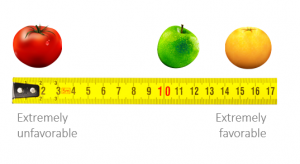2.Survey: Measurement and Scaling
2.1 Introduction
Measurement

Measurement – assigning numbers or other symbols to characteristics of objects according to certain pre-specified rule
– one-to-one correspondence between the numbers and characteristics being measured
– the rules for assigning numbers should be standardized and applied uniformly
– rules must not change over objects or time
Scaling

Scaling – involves creating a continuum upon which measured objects are located.
Primary Scales of Measurement
Nominal:
- numbers serve as labels for identifying and classifying objects
- not continuos
Ordinal:
- numbers indicate the relative positions of objects
- but not the magnitude of difference between them
Interval:
- differences between objects can be compared
- zero point is arbitrary
Ratio a.k.a. metric:
- zero point is fixed
- ratios of scale values can be computed
Primary Scales of Measurement
| Scale | Basic Characteristics | Common Examples | Marketing Examples |
Permissible Statistics |
|
|
Descriptive |
Inferential |
||||
|
Nominal |
Numbers identify and classify objects |
Social security numbers, numbering of football players |
Brand numbers, store types sex, classification |
Percentages, mode |
Chi-square, binomial test |
|
Ordinal |
Numbers indicate the relative positions of the objects but not the magnitude of differences between them |
Quality rankings, ranking of teams in tournament |
Preference rankings, market position, social class |
Percentile, median |
Rank-order correlation, Friedman ANOVA |
|
Interval |
Differences between objects can be compared; zero point is arbitrary |
Temperature (Fahrenheit, Centigrade) |
Attitudes, opinions, index numbers |
Range, mean, standard deviation |
Product-moment correlations, t-tests, ANOVA, regression, factor analysis |
|
Ratio |
Zero point is fixed; ratios of scale values can be compared |
Length, weight, time, money |
Age, income, costs, sales, market shares |
Geometric mean, harmonic mean |
Coefficient of variation |
Classification of Scaling Techniques
Comparison of Scaling Techniques
Comparative Scales:
- involve the direct comparison of stimulus objects.
- data must be interpreted in relative terms
- have only ordinal and rank-order properties
Non-comparative Scales:
- each object is scaled independently
- resulting data is generally assumed to be interval or ratio scaled
– nature of the research
– variability in the population
– statistical considerations
To the table of contents

